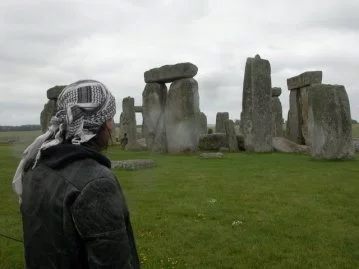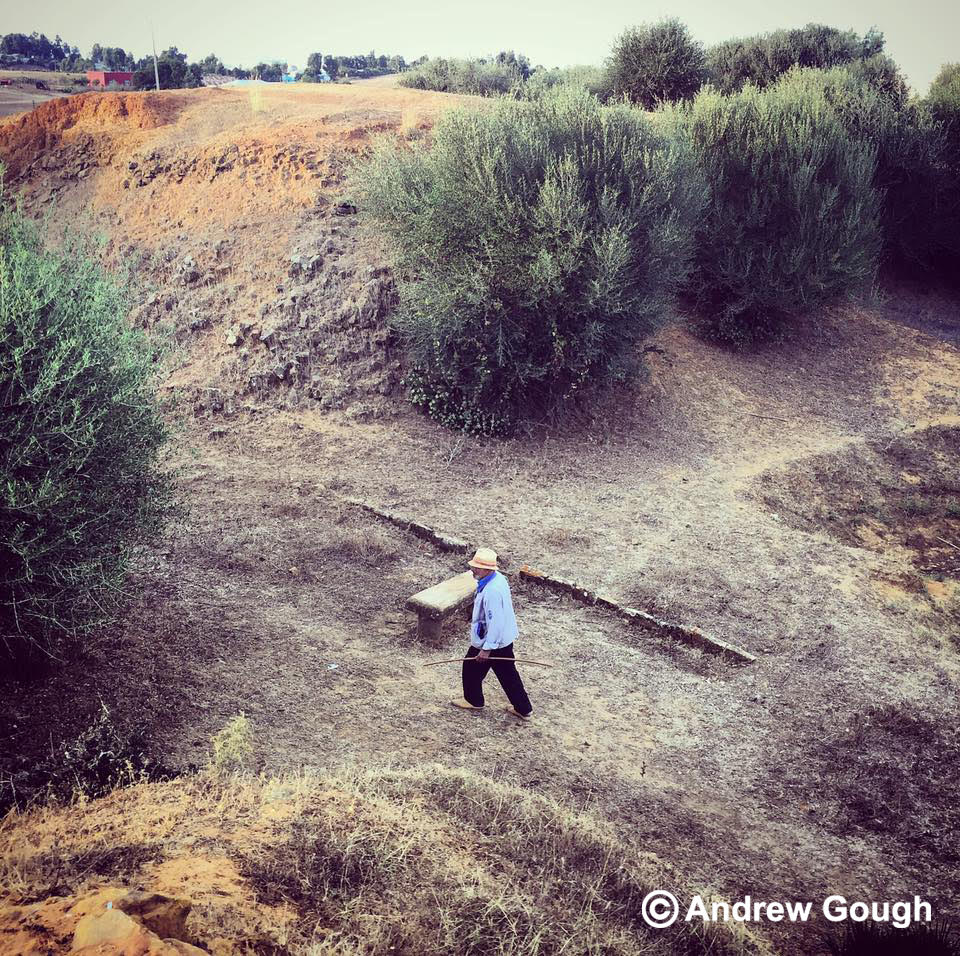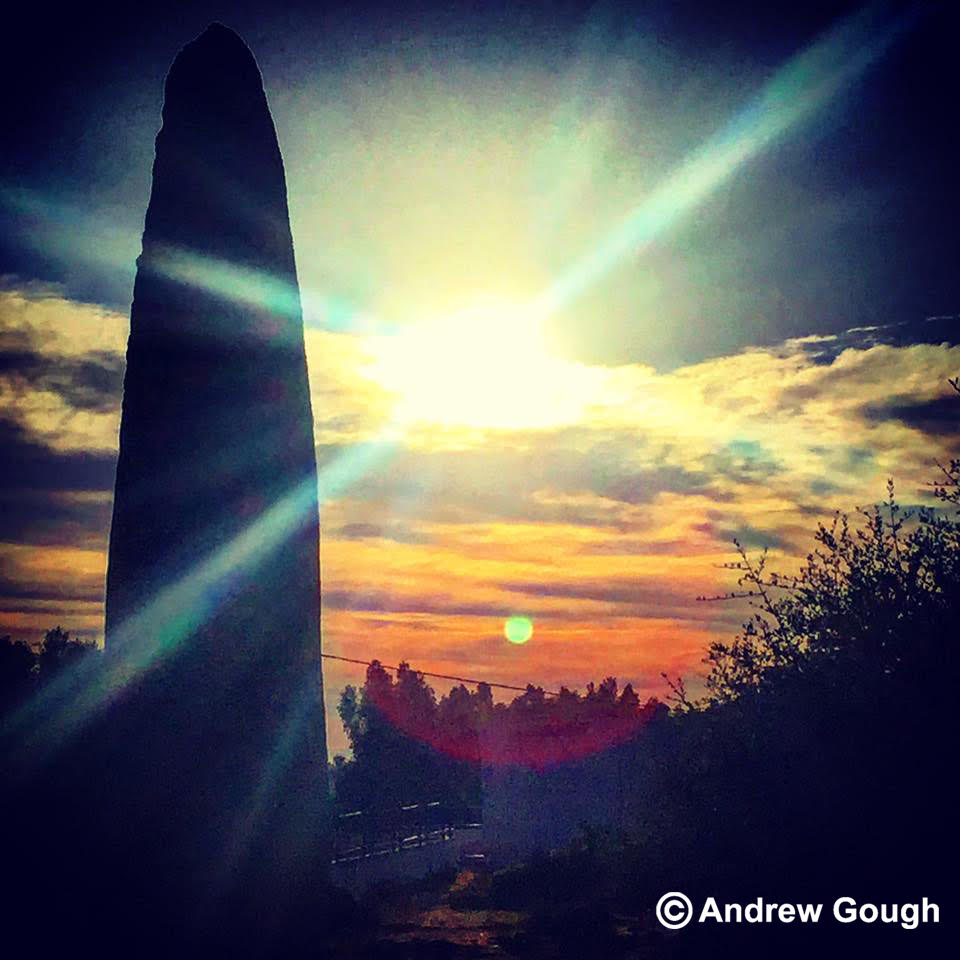“As for me, I am tormented with an everlasting itch for things remote. I love to sail forbidden seas, and land on barbarous coasts.”
Herman Melville, Moby-Dick
 In the north of Morocco, in the countryside south of Tangier, is an ancient site known as Msoura, or the Msoura Ring. To provide the simplest and the shortest description, Msoura is made up of a circle or ellipse of 167 standing stones, the largest of which is known as El Uted, or The Pointer, which stands over 5 meters high. Most of these huge stones seem to have been broken at some point, while other megaliths lie fallen elsewhere in the vicinity.
In the north of Morocco, in the countryside south of Tangier, is an ancient site known as Msoura, or the Msoura Ring. To provide the simplest and the shortest description, Msoura is made up of a circle or ellipse of 167 standing stones, the largest of which is known as El Uted, or The Pointer, which stands over 5 meters high. Most of these huge stones seem to have been broken at some point, while other megaliths lie fallen elsewhere in the vicinity.
Inside this stone circle lie the remains of a vast tumulus or burial mound, described as fifty-five meters across and six meters high. As far as I understand, we do not know if the tumulus predates the stone circle, if the circle predates the tumulus or if both structures were raised at the same time. There is a cornucopia of fascinating aspects to this site and I will present just a few of them in this post, but good manners compel me to make clear at the start that I shall leave the curious reader to discover the vast majority of the details for himself or herself, as I wouldn’t knowingly deprive another soul of the intense pleasure that arises from the prolonged contemplation of these matters.
 There seems to have been a belief that the giant Antaeus was buried in this place after losing his fight with Hercules, who fought and slew Antaeus either before or after his visit to the Garden of the Hesperides to steal the golden apples. There seems to be little doubt that Plutarch wrote in some detail about this strange tomb in an intriguing passage in his description of the life of the Roman general Sertorius [123 – 72 BC]:
There seems to have been a belief that the giant Antaeus was buried in this place after losing his fight with Hercules, who fought and slew Antaeus either before or after his visit to the Garden of the Hesperides to steal the golden apples. There seems to be little doubt that Plutarch wrote in some detail about this strange tomb in an intriguing passage in his description of the life of the Roman general Sertorius [123 – 72 BC]:
“His [Sertorius’s] arrival in Mauritania being very acceptable to the Moors, he lost no time, but immediately giving battle to Ascalis, beat him out of the field and besieged him; and Paccianus being sent by Sylla, with a powerful supply, to raise the siege, Sertorius slew him in the field, gained over all his forces, and took the city of Tingis, into which Ascalis and his brothers were fled for refuge. The Africans tell that Antaeus was buried in this city, and Sertorius had the grave opened, doubting the story because of the prodigious size, and finding there his body, in effect, it is said, full sixty cubits long, he was infinitely astonished, offered sacrifice, and heaped up the tomb again, gave his confirmation to the story, and added new honours to the memory of Antaeus. The Africans tell that after the death of Antaeus, his wife Tinga lived with Hercules, and had a son by him called Sophax, who was king of these countries, and gave his mother’s name to this city, whose son, also, was Diodorus, a great conqueror, who brought the greatest part of the Libyan tribes under his subjection, with an army of Greeks, raised out of the colonies of the Olbians and Myceneans placed here by Hercules.”

I’m sure that a detailed study of Plutarch’s original text would repay the time and trouble put into it, but Dryden’s translation shows that something truly extraordinary took place. To begin with, however, there is a problem with the location of the grave, as Plutarch repeats the words of the Africans, that Antaeus was buried in the city of Tingis, or modern Tangier, whereas the Msoura Ring is some miles to the south. It may be that Plutarch’s original text allows for a sense of the grave to lie with the boundaries of a city state, or in a realm or region ruled over by a city, but this remains to be seen.
Be that as it may, the sense of the account of Sertorius being made aware of the grave strongly suggests that while he accepted that Antaeus was a historical figure rather than one from mythology and was furthermore a giant, the tumulus or burial mound was so huge that he doubted that any giant could have been so big. If Sertorius had possessed even a passing interest in these matters, he must surely have known that burial mounds or tumuli were always bigger, to a greater or lesser extent, that those entombed within them, so a huge mound would not have automatically suggested the presence within of an almost equally huge corpse.
Logic further suggests that when Sertorius was told about this being the grave of Antaeus, his informants must have assured him that a truly colossal set of bones was buried beneath the mound, as Plutarch tells us in as many words that Sertorius had the tumulus opened to prove or disprove the incredible assertions that had been made to him. Of course, there isn’t a snowball’s chance in Hell of any archaeologist or scientist admitting that there were once giants, let alone towering creatures to whom we were virtually ants by comparison, but Plutarch is admirably and unambiguously clear on this point.
He tells us that “…finding there his body, in effect, it is said, full sixty cubits long, he was infinitely astonished…” I’m not remotely surprised that Sertorius was infinitely astonished, because by my embarrassingly amateurish calculations, the remains that Sertorius’s men discovered in that unearthly tomb must have been roughly ninety feet tall.
We might not have been surprised if Plutarch had ended the story there, perhaps finishing with something along the lines of “Or so the old story goes” as a minor postscript or qualifier, but he did not. Instead, he records that after Sertorius had been infinitely astonished by the sheer size of the body he’d seen, he “…offered sacrifice, and heaped up the tomb again, gave his confirmation to the story, and added new honours to the memory of Antaeus.” It’s hard to imagine a more positive affirmation that this grave once held an unimaginably huge body than the one we have seen in Plutarch’s detailed account, but there are many other intriguing aspects to this ruin that is astonishingly so little-known.
 The Msoura Ring may be a forgotten ruin in the middle of nowhere, but it seems that there’s a very good chance that we know some concrete details about it from antiquity, thanks to Plutarch. For example, we can reasonably infer from his account that the people of the region were so insistent that the body of Antaeus, an inconceivably huge giant, was buried in the mound, that their faith and lurid tales prompted a Roman general to get his men to unearth this giant’s remains, so that he could see and judge for himself.
The Msoura Ring may be a forgotten ruin in the middle of nowhere, but it seems that there’s a very good chance that we know some concrete details about it from antiquity, thanks to Plutarch. For example, we can reasonably infer from his account that the people of the region were so insistent that the body of Antaeus, an inconceivably huge giant, was buried in the mound, that their faith and lurid tales prompted a Roman general to get his men to unearth this giant’s remains, so that he could see and judge for himself.
Careful and meticulous excavation of the site ought to be able to tell us if the tumulus was indeed opened in the early part of the first century BC, when Sertorius was in the region, while it’s not unthinkable that evidence might be found of some of the other things that Plutarch mentioned, such as rebuilding of the mound at that time and propitiatory sacrifices of some kind. After all, in recent times, Stonehenge has suffered centuries of abuse and destruction, including a terrible period during the 1950s and 1960s under the archaeologist Professor Richard Atkinson, but we are still occasionally able to glean knowledge of minor wonders from its remains. Some of this is due to archaeological excavation and subsequent study, but I’ve personally spent around two decades finding illuminating original information on Stonehenge from other sources.
Just one of the many things that consistently amazes me about Stonehenge is the way in which it is always described as a mysterious place with unknown origins, yet just as is the case with the Msoura Ring, we have a clear, detailed written account of how it came into being. This account or history was provided by the 12th century writer Geoffrey of Monmouth, who said that Stonehenge was intended as a memorial by King Aurelius to the three hundred British elders of King Vortigern who were treacherously slain by Hengist and his household. Aurelius summoned Merlin, who had learned of the king’s wishes for a memorial and the wizard replied to them in this now famous exchange:
“If you are desirous,” said Merlin, “to honor the burying-place of these men with an everlasting monument, send for the Giant’s Dance [Stonehenge], which is in Killaraus, a mountain in Ireland. For there is a structure of stones there, which none of this age could raise, without a profound knowledge of the mechanical arts. They are stones of a vast magnitude and wonderful quality; and if they can be placed here, as they are there, round this spot of ground, they will stand forever.”
At these words of Merlin, Aurelius burst into laughter, and said, “How is it possible to remove such vast stones from so distant a country, as if Britain was not furnished with stones fit for the work?”
Merlin replied: “I entreat your majesty to forbear vain laughter; for what I say is without vanity. They are mystical stones, and of a medicinal virtue. The giants of old brought them from the farthest coasts of Africa, and placed them in Ireland, while they inhabited that country. Their design in this was to make baths in them, when they should be taken with any illness. For their method was to wash the stones, and put their sick into the water, which infallibly cured them. With the like success they cured wounds also, adding only the application of some herbs. There is not a stone there which has not some healing virtue.”

Naturally, one highly intriguing aspect of these revelations of the origins of Stonehenge by Merlin is that the stones were brought to Ireland, apparently, by giants of old from the farthest coasts of Africa. One would imagine that the location of the farthest coasts of Africa would depend on a number of factors, one necessarily being the land in which an observer was writing, but there’s a good case to be made that the precise area in which the enigmatic Msoura stone circle is situated was regarded as one of these “farthest coasts”.
Without going into the vast amount of enchanting detail available on the subject, we know that the Garden of the Hesperides, the place to which Hercules travelled to fulfill his eleventh labour, slaying Antaeus somewhere along the way, was thought to be in the region of the Atlas mountains of north Africa and close to what we now call the Atlantic Ocean; in other words, as far as the Greeks and Hercules himself were concerned, they were the farthest coasts of Africa, far to the west where the sun set and where the Earth was girdled by the River of Ocean. How strange it is, then, bearing in mind Merlin’s description of the origin of Stonehenge, for us to learn of the discovery in antiquity of the body of a real giant, an event that was recorded as an historical happening rather than as a legend, while this giant’s tomb lay inside a huge stone circle at the farthest coasts of Africa.
The wonders do not end there, though, because I learn from elsewhere on the internet that in former times, the Berber people inhabiting the area believed that the stones and the tumulus had been raised by Djouhalas, or pagan giants from a time predating Islam. I do not know if this is true or not, but if it is, it is yet another intriguing echo of what Geoffrey of Monmouth told us about the origins of Stonehenge.
I also understand from a number of sources that the name “Mzoura” means “The First Ones”, but I do not know if this is true, either, while if it is indeed reliable, I do not know which “ones” are referred to. It may well have been remarked upon elsewhere by others before me, but when I pore over Plutarch’s description of the body of Antaeus being sixty cubits long, I am immediately reminded of an Islamic tradition that says that Allah created Adam and made him sixty cubits tall, although I don’t know if this size was said to have existed on Earth or later in Paradise, after Adam’s death. Either way, I find it to be an absolutely amazing coincidence that Adam was indisputably one of the ‘first ones’ or first human beings created on Earth and that there’s a well-documented tradition saying that at some point, he measured sixty cubits, while there exists a written record of a body measuring sixty cubits having been found in a set of ruins known as “The First Ones”.

I could continue in this vein for hours more, because as I said towards the start of this post, there is a cornucopia of fascinating aspects to this site. As I have detailed above, the Msoura Ring has a number of tantalising links to Stonehenge, which in turn is arguably the world’s most famous and enigmatic prehistoric site, to which roughly a million visitors a year are drawn. Stonehenge is rarely out of the news, but nowhere will you find so much as a mention of the Msoura Ring in connection with it, as far as officialdom is concerned.
A reasonable person might think that after Professor Atkinson’s rampage at Stonehenge, at the end of which he referred to the original builders of the monument as “Practically savages – howling barbarians”, the present custodians of Stonehenge might feel the need to inform the public about this astonishing monument to the fullest extent possible by way of compensating for the way that Atkinson ransacked the site for years, yet only published a bare minimum of his findings before he died.
As things stand, however, the amount of illuminating, thought-provoking information on Stonehenge available online to a casual enquirer from the general public is minimal, particularly so if the unfortunate querent is naive enough to go to what one might call an “official” source in the course of their search for enlightenment. When there is scant official acknowledgement that sites such as Bluestonehenge and the “Cradle of Stonehenge” at Blick Mead even exist, then we cannot be surprised that such seemingly exotic, Stonehenge-related subjects such as the Druids, the missing altar stone, Stukeley’s tablet of tin whose loss is “eternally to be lamented”, the Msoura Ring and countless others aren’t deemed worthy of mention in polite circles, let alone discussion.
Nonetheless, along with beliefs from a former time that Stonehenge was the last resting place of Boadicea, or that it was once visited by Joseph of Arimathea, these endlessly fascinating subjects comprise our intangible cultural heritage, so they deserve not just to be preserved, but to be promoted far and wide so that as many people as possible the world over can bask in the sense of wonderment that inevitably ensues from prolonged contemplation of these arcane and enchanting things.
There are others besides myself who are captivated by the enchantment that permeates the Stonehenge landscape and seek to preserve it, one being Austin Kinsley, creator of the Silent Earth site. On this occasion, I am indebted to my American friend of long standing Andrew Gough, who recently visited the Msoura Ring and with typical generosity of spirit, allowed me to use some of the photos he’d taken while he was there.
 Andrew was researching the site, after which he presented his extensive findings on an episode of Discovery Science’s “What On Earth” series. This involved speaking to the site’s current caretaker with the help of an Arabic interpreter, while he discovered much else in addition to the meager fare I’ve posted above concerning Sertorius and Stonehenge.
Andrew was researching the site, after which he presented his extensive findings on an episode of Discovery Science’s “What On Earth” series. This involved speaking to the site’s current caretaker with the help of an Arabic interpreter, while he discovered much else in addition to the meager fare I’ve posted above concerning Sertorius and Stonehenge.
As a few examples, Andrew looked into the curious affair of the Spanish archaeologist Montalban, who extensively excavated the site of Msoura in the 1930s, but who was thrown into prison and who died there before he could publish his findings, so no one seems to know what he discovered there. The site’s guardian informed Andrew that in recent times, the Moroccan military had stood guard at the ruins for days, while there remains the belief in some quarters that treasure is buried there, awaiting discovery.

There are yet more stories of the remote site being cursed, along with tales of some excavators having gone mad, while I’ve read elsewhere that some people in the region are said to refer to it as “The Devil’s Temple”. Anyone who is familiar with the rampages of the antiquarians in Britain and with the voluminous folklore attached to our barrows or burial mounds will find these stories eerily familiar, so in my view, it’s hard to overstate the cultural value that the Msoura Ring holds for us all.
The better-known it becomes, the more likely it will be that our Moroccan brothers and sisters can eventually benefit from something approaching the kind of tourist numbers that Stonehenge or the Giants’ Dance has enjoyed for so long, while we in turn can only become richer through learning of ancient giants, Roman generals and dusty ruins, somewhere on the farthest coasts of Africa.

Once more, I’m enormously grateful to Juris Ozols of MOJO Productions for his infinite patience and technical assistance. All photos taken in Morocco are copyright and the property of Andrew Gough.
“It is not down on any map; true places never are.”
Herman Melville, Moby-Dick